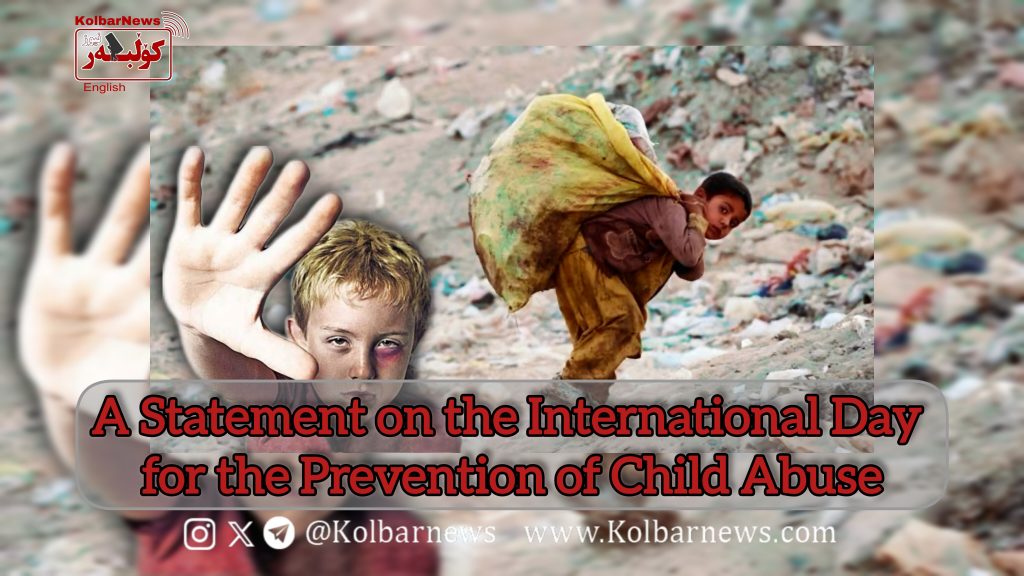
November 19, 2024, is recognized as the International Day for the Prevention of Child Abuse. Among the many hardships imposed on the world’s 8 billion people by the capitalist system, the suffering endured by children, particularly girls, stands out as profoundly distressing. This day was proposed in 2000 by activists combating violence and abuse against children during the World Women’s Summit. It coincides with November 20, the UN-designated date for the adoption of the Convention on the Rights of the Child and Universal Children’s Day.
Forms of Child Abuse
Child abuse is generally categorized into four types: psychological or emotional, physical, sexual, and neglect. Numerous factors contribute to child abuse, including exploitation, inequality, war, poverty, discrimination, religion, traditions, workplace violence, unhealthy educational environments, and regressive family structures.
Global Perspective: Abuse in Palestine
One of the most egregious examples of child abuse occurs in Palestine. Israeli military forces subject Palestinian children, especially those in Gaza, to various forms of abuse, stripping them of their rights to life, education, proper housing, healthcare, and most horrifically, their right to life itself through brutal killings. A March 10, 2024, report from the UN Documentation Center highlighted a surge in violence against Palestinian children following October 7, 2023. This report also documented the detention and physical and psychological torture of hundreds of Palestinian children in Israeli prisons.
Recently, the Israeli Knesset passed a law banning the operations of the United Nations Relief and Works Agency for Palestine Refugees (UNRWA), especially in Gaza. UNRWA employs 13,000 individuals to provide educational and healthcare services to Palestinians, including children. Journalist Rami Abu Jamous described the ban as cutting off the lifeline for Gaza’s surviving residents, particularly children.
Abuse in Iran under the Islamic Republic
In Iran, systemic child abuse primarily affects the children of laborers and impoverished families. Factors such as poverty, deprivation of education, and forced labor in unsafe environments like garbage sorting or street work are pervasive. Many children fall victim to mafia networks, including drug trafficking rings that exploit them for drug transport or sex work, especially targeting girls. Evidence suggests ties between these networks and the Islamic Revolutionary Guard Corps (IRGC). Some girls are trafficked to Gulf countries for sexual exploitation or sold to wealthy sheikhs. Others are prepared for temporary marriages (sigheh) with tourists in cities like Mashhad and Shiraz. Officials like Ahmad Alamolhoda, the Friday prayer leader of Mashhad, have even justified such practices, claiming they bring blessings to Iran.
Clerics also sanction marriages of girls as young as nine to older men, a deeply troubling practice that often leads to the girls becoming mothers at a young age.
The IRGC exploits street children and detained minors as child soldiers, using them in protests and suppressing uprisings, such as during the “Jina” (Mahsa Amini) revolution. It is reported that the IRGC deliberately shared photos of these children on social media to ostracize them from society permanently.
The Broader Context
These are just a few examples of the abuses inflicted on registered children in Iran under the Islamic Republic. The situation is even worse for undocumented children and the offspring of Afghan migrants, who face intensified discrimination and abuse.
Root Causes and Solutions
Child abuse in Iran is a direct consequence of the political and economic systems imposed by the Islamic Republic and its capitalist structures. Poverty and inequality devastate families, while clerics like Alireza Arafi and Mehdi Mirbagheri justify these conditions as necessary for the emergence of the Hidden Imam, further perpetuating suffering.
Ending this systemic abuse requires addressing the root causes: overthrowing the oppressive regime and dismantling the exploitative capitalist system that sustains it. Only then can children and their families hope for a future free from abuse and exploitation.

